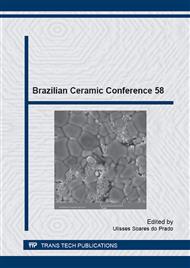p.411
p.419
p.425
p.432
p.438
p.443
p.449
p.455
p.462
Characterization of Precursor Clay Body and Weibull Analysis of the Compressive Strength of Structural Blocks
Abstract:
The modern concepts of civil construction for building with a maximum of 5 stores rely on structural blocks to support part of the load. These are normally hollow parallelepiped pieces made of concrete or fired ceramic. In Brazil, the abundance and easy to mine natural clay deposits favor the use of structural blocks fabricated of fired clay ceramics. Moreover, the available wood from reforestation, as fuel for the ceramic furnaces has the advantages of a less expensive and environmentally correct source of energy. Since the main property of a structural block is its compressive strength, special care should be taken in its evaluation. The ceramic industries in Campos dos Goytacazes, traditionally involved in the fabrication of simple non-structural clay bricks, are currently interested in producing structural blocks to attend large scale governmental housing programs. In order to evaluate the mechanical performance of these structural blocks, the preset work carried out a statistical study of their compressive strength by means of the Weibull analysis together with a characterization of the precursor clay body. The results indicated that the structural blocks comply with the norm and confirmed a valid number of tested specimens.
Info:
Periodical:
Pages:
438-442
Citation:
Online since:
June 2015
Price:
Сopyright:
© 2015 Trans Tech Publications Ltd. All Rights Reserved
Share:
Citation:


